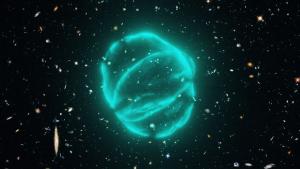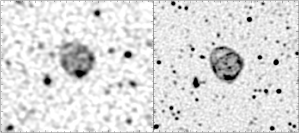Blog
Odd Radio Circles
24 March 2022
 CSIRO
CSIROIn radio astronomy, circle-shaped objects are fairly common. Since diffuse ionized gas often emits radio light, objects such as supernova remnants, planetary nebulae, and even star-forming regions can create circular arcs of diffuse gas. But in 2019 astronomers began to discover radio circles they couldn’t explain, in part because they are so large.
Known as Odd Radio Circles, or ORCs, they are roughly a million light-years across, which is about ten times wider than the Milky Way. Observations show that ORCs are centered around an elliptical galaxy, which suggests a galactic connection. It has been suggested that ORCs are formed by shock waves triggered by a powerful event such as a gamma-ray burst or fast radio burst, but given the size of ORCs, these events would need to have been triggered very far in the past. And shock waves can typically be seen in other wavelengths such as infrared and x-rays, but ORCs are only seen in radio light.
 The EMU team, using ASKAP and MeerKAT radio continuum data
The EMU team, using ASKAP and MeerKAT radio continuum dataBut a new study suggests other possible origins.1 Using the MeerKAT radio telescope, the team captured new data from one of the six confirmed ORCs, creating the highest resolution image so far. This revealed ring structures not previously seen. The team also measured the polarization of light from the ORC, which helped them narrow down possible causes.
Based on the observations, the light is consistent with that of synchrotron radiation. This occurs when charged particles are caught within a magnetic field. As the particles spiral along magnetic field lines, they emit a faint radio light. This often occurs with diffuse plasma, and it suggests a spherical shell gas was pushed away from the galaxy either through a rapid period of star production or the merger of supermassive black holes.
Another interesting possibility is that ORCs are formed by the galaxy’s supermassive black hole directly. Active galactic black holes, or active galactic nuclei (AGNs) as they are commonly known, often cause jets of material to stream away from the black hole at nearly the speed of light. Over time these can create vast radio lobes, where long-ejected plasma glows in radio light. One idea is that ORCs are caused by radio lobes oriented along our line of sight. Rather than seeing ejected plasma as a lobe, we would see it as glowing radio arcs.
While this study has narrowed down the possible explanations for ORCs, there isn’t one clear solution. But the team is undertaking further studies to look for more clues. And when future radio telescopes such as the Square Kilometer Array (SKA) are completed, were are bound to discover even more ORCs.
Norris, Ray P., et al. “MeerKAT uncovers the physics of an Odd Radio Circle.” arXiv preprint arXiv:2203.10669 (2022). ↩︎